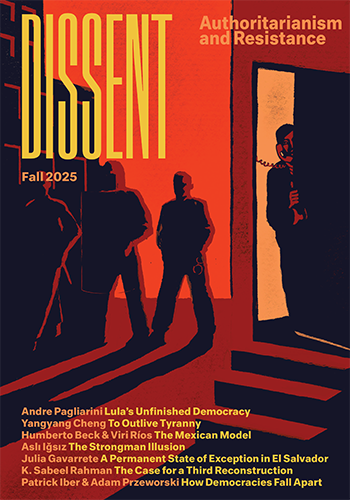Rage and Prayer in Los Angeles
Rage and Prayer in Los Angeles
The task of this moment is to build a broad front that can resist authoritarianism. The recent protests are early skirmishes in the fight that will be needed.

Los Angeles is convulsing—and maybe being reborn. The immediate trigger was the unleashing of Immigration and Customs Enforcement (ICE) agents upon the region, a tactic adopted after White House Deputy Chief of Staff Stephen Miller—appropriately labeled “vile” by a journalist who was suspended for speaking truth to power—became frustrated with what he saw as the slow pace of deportations.
ICE arrests are up, but not as much as the administration hoped. As it turns out, focusing on the “worst of the worst” (those with a proven criminal record), as Trump promised to do, is tough work; immigrants who have a lot to hide tend to do just that. It’s much easier to send authorities to a target-rich environment where they can easily locate and arrest day laborers, car washers, and parents dropping their kids off at school.
That’s Los Angeles, of course. A place where nearly a fifth of the population is either undocumented or a U.S. citizen or documented immigrant living in a mixed-status family. A place where roughly a third of our residential construction labor force—key to rebuilding after the January fires—works without papers. A place where immigrant rights activists have built a social movement infrastructure that is parallel to none.
ICE raids ripped their way through the L.A. region on Friday, June 6, with the locations of choice including a Home Depot near Downtown L.A. and an apparel company where workers with nearly two decades in the country—and dependent family members who rely on their income—were arrested and transported to detention.
Or perhaps better put, shipped into a vortex where due process is abrogated, lawyers are not made available, and information is scarce. Immigrant rights activists and family members find themselves spending time trying to find out just who was kidnapped and where they might be held—and knowing that no amount of ransom will get them back from a regime dedicated to the theatrics of cruelty.
Los Angeles fought back—occasionally in ways that have spilled over into violence. I was at City Hall on Sunday night and got a first-hand glimpse. I was headed there because of a prayer vigil, one that was called off because of the emerging possibility of violence (prescient as it turns out). I went nonetheless to meet a community leader and friend who was helping to steer people away who had come for the vigil and found themselves in a crowd that seemed ready for full-scale confrontation.
The easiest arrival to identify as one of “our people” was a ninety-year-old priest who showed up late to the gathering and was eager to warn everyone of the threats of impending fascism. On the stole draping his shoulders was a picture of the Catholic Saint Maximilian Kolbe, a Polish priest famous for his resistance to the Nazis. One of the acts that got him canonized as a martyr was offering to take the place of one of ten men Auschwitz guards chose to starve to death as collective punishment for a prisoner escape.
As the priest patiently told the story, the police geared up to charge the crowd. About half a football field away, some on the protest side had stripped out benches and created a barricade between them and officers who were shooting projectiles and flash-bang grenades. Behind the barricade, folks tossed water bottles, then metal bars, and eventually shot off fireworks. Finally, officers charged, some on horseback and some on foot, and released a barrage of tear gas in our direction.
My friend and I were already stepping away, and we had urged the priest to do the same (to our surprise, he lingered). Our own ginger steps turned to a run as tear gas was fired, horses were mounted, and the barricades were overrun. It was, as one of my organizer allies would say, a “spicy” moment. There were clearly some who wanted and relished the conflict—agitators and provocateurs are always in the mix—but the striking thing to me was the large number of young people milling around who were just incredibly pissed off. Their view: this is our city, our families, and our future. They were determined to resist those seeking to rewrite our identity and our destiny.
This raises a question that reverberates beyond the landscape of Los Angeles in a moment in which authoritarianism is on the rise: how do we effectively channel the hot rage of protest into the cold anger of strategy? Marches and tame demonstrations are not enough: we must instead muster a real (and hopefully nonviolent) way to jam the system, stop the deportations, and so much more. The latest barrage from the Trump administration seems to be angering not just activists but nearly everyone, offering the real possibility of a new broad front.
Local police forces have been baited into a fight they did not want; on that same Sunday, National Guard troops surged into a peaceful but vocal crowd with riot shields, smoke grenades, and tear gas—and then withdrew to leave the resulting hours-long battle to the locals. State and local political figures, including Mayor Karen Bass and Governor Gavin Newsom, are pushing back against the heavy hand of Washington.
This was the first time National Guard troops have been deployed without the request of a state’s governor since the 1960s. In that era, the National Guard was there to protect civil rights marchers from racist and vindictive state authorities. Now, the intention is to sow chaos and fear, and to enact what is clearly a racist and vindictive strategy on a city that wants no part of Trump’s agenda.
To some extent, Trump’s strategy is working—if you define working as getting the television images he craves. What is less clear is whether it will eventually play well with the public. In keeping with the nation’s polarization, he is getting high marks (nearly 90 percent approval) from Republicans. In stirring up his own base, he has been helped by a media too often eager to portray all of Los Angeles as on fire—when, in fact, people were dining outdoors just blocks away from the action—and too infrequently focused on the families whose lives are touched and torched by the government’s actions.
As the raids and riots continue, Los Angeles has begun to find its footing. Monday brought a large demonstration in a downtown park, organized by SEIU California, whose president David Huerta had been arrested the previous Friday at one of the ICE raids. Injured in the process, he spent the weekend in custody and was then charged with “conspiracy to impede an officer,” a chilling response to protest and one likely to keep labor engaged in this bigger movement for justice.
On Tuesday night, a vigil led by faith leaders—representing Catholic, Protestant, Jewish, Muslim, Sikh, and other traditions—attracted a large crowd in the same downtown park. I will admit my own initial frustration at that event. From the stage rang calls for peace and nostalgic renditions of 1960s folk songs; I kept thinking this was out of sync when the emotion of the moment is indignation and the soundtrack of contemporary Los Angeles is Kendrick Lamar’s diss track “Not Like Us.”
But then a bit of bravery—and indeed magic—occurred. As the event ended, faith leaders and about half the crowd marched out from the park, trekking through what had been a highly localized war zone to the nearby Federal Building. They were greeted by officers from the Department of Homeland Security who trained pepper ball guns on the crowd. They responded by taking a knee, offering flowers, and praying.
Perhaps more remarkable was what happened along the way. The phalanx of faith had come across a group of young protesters chanting slogans, waving flags, and hoisting signs that said “Fuck ICE”—a sentiment that was raw but real given the pain that has been caused by Trump’s commitment to cruelty. Meanwhile, the faith leaders were singing “This Little Light of Mine” and carrying banners with the words “Families are Sacred.”
It should have been a sonic and generational clash. But the tune and message were soon picked up by youth seemingly happy that someone was meeting them where they were—in their desperation and on the streets—and then leading them to courageous but considered confrontation. And when the faith leaders started praying—straight in the face of the armed state—the young protesters knelt and joined, demonstrating how a quieter strength could both fuel resistance and project a different image. The next night, a newly popular chant began ricocheting through the streets of the city’s downtown: “Peaceful protest.”
The task of this moment and the years ahead is to build a broad front that can resist the turn to authoritarianism. These last few days in Los Angeles are early skirmishes in the fight that will be needed to build that front: one that challenges Trump but also figures out how to link those who are immigrant and those who are native-born, those who are faithful and those who are furious, those who are woke and those to be awakened, into a single struggle for multiracial democracy.
The stakes could not be higher. It’s easy to think that this is just about borders and migrants. But the attack on immigrants now is a dry run for the strongman tactics that will later be used on us all. And finding a path of resistance that is fierce but not reckless, mass but not middling, strong but not violent will be a challenge. From the streets, communities, and workplaces, Los Angeles is rising—and hoping the nation will join in a fight for opportunity, community, and dignity for all.
Manuel Pastor is a Distinguished Professor of Sociology and American Studies & Ethnicity at the University of Southern California and director of the Equity Research Institute. He is the coauthor, with Chris Benner, of Charging Forward: Lithium Valley, Electric Vehicles, and a Just Future.






